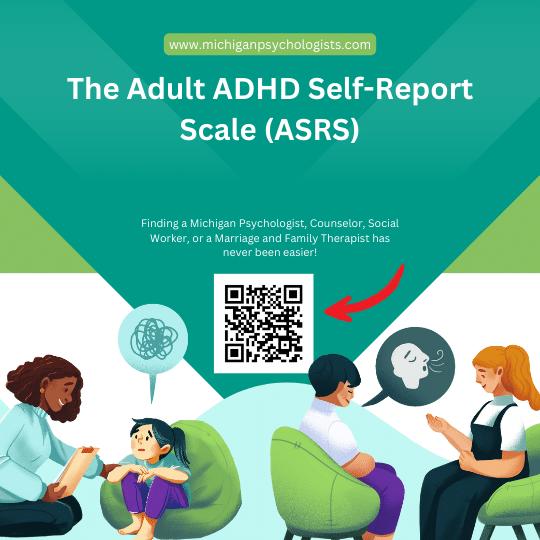The Adult ADHD Self-Report Scale (ASRS)
Home » Psychological Tests » ADHD Tests and Screeners » The Adult ADHD Self-Report Scale (ASRS)

Table of Contents
Attention Deficit Hyperactivity Disorder (ADHD) is often perceived as a childhood condition, but its symptoms frequently persist into adulthood, impacting various aspects of daily life, including work, relationships, and overall well-being. The Adult ADHD Self-Report Scale (ASRS) is a valuable tool designed to help identify ADHD symptoms in adults. This comprehensive guide will explore the ASRS test from a psychologist’s perspective, delving into what it is, how it is scored, and its accuracy in diagnosing ADHD.
What is the Adult ADHD Self-Report Scale (ASRS)?
The Adult ADHD Self-Report Scale (ASRS) is a screening tool developed by the World Health Organization (WHO) in collaboration with the Workgroup on Adult ADHD. The ASRS is specifically designed to measure the frequency of ADHD symptoms in adults, providing a quick and efficient method to identify those who may benefit from a more comprehensive evaluation.
Key Features of the ASRS
Structure: The ASRS consists of 18 questions based on the diagnostic criteria outlined in the DSM-5 (Diagnostic and Statistical Manual of Mental Disorders, Fifth Edition). These questions are divided into two parts:
- Part A: The first 6 questions focus on the most predictive symptoms of ADHD.
- Part B: The remaining 12 questions cover the broader range of symptoms associated with ADHD.
Symptom Domains: The ASRS assesses symptoms across two primary domains:
- Inattention: Difficulties with sustaining attention, following through on tasks, and organizing activities.
- Hyperactivity-Impulsivity: Excessive movement, fidgeting, and impulsive actions.
Administration: The ASRS can be self-administered or conducted with the assistance of a healthcare professional. It is designed to be completed in a short amount of time, typically within 5-10 minutes.
How to Score the Adult ADHD Self-Report Scale (ASRS)
Scoring the ASRS involves evaluating the frequency of each symptom as reported by the individual. Each question on the ASRS is rated on a five-point Likert scale:
- Never (0 points)
- Rarely (1 point)
- Sometimes (2 points)
- Often (3 points)
- Very Often (4 points)
Scoring Part A
The six questions in Part A are critical in the initial screening process. Each response is scored, and the total score for Part A is calculated. A total score of 14 or higher in Part A suggests that the individual may have ADHD and should seek further evaluation.
Scoring Part B
The twelve questions in Part B provide additional information about the presence and severity of ADHD symptoms. While Part A is the primary focus for initial screening, Part B helps to capture a comprehensive view of the individual’s symptomatology.
Interpreting the Results
- Total Score: The combined total score from both parts provides an overall indication of ADHD symptom severity. Higher scores indicate a greater likelihood of ADHD.
- Symptom Frequency: The frequency of specific symptoms can guide further diagnostic evaluations and treatment planning.
- Clinical Judgment: While the ASRS is a valuable screening tool, it is not a diagnostic instrument. A comprehensive clinical evaluation, including a detailed history and additional assessments, is necessary to confirm an ADHD diagnosis.
How Accurate is the Adult ADHD Self-Report Scale (ASRS)?
The accuracy of the ASRS is an important consideration for both clinicians and individuals seeking to understand their symptoms better. The ASRS has been extensively researched and validated, demonstrating strong psychometric properties.
Sensitivity and Specificity
- Sensitivity: The ASRS has high sensitivity, meaning it is effective at correctly identifying individuals who have ADHD. Studies have shown that the ASRS Part A, in particular, has a sensitivity rate of approximately 84%.
- Specificity: The ASRS also exhibits good specificity, indicating its ability to correctly identify individuals who do not have ADHD. The specificity rate for ASRS Part A is around 66%.
Reliability
The ASRS has demonstrated high internal consistency and test-retest reliability. This means that the tool produces stable and consistent results over time and across different populations.
Validity
The ASRS is considered a valid screening instrument for adult ADHD. It has been shown to correlate well with clinical diagnoses of ADHD and other established ADHD assessment tools. Its validity is further supported by its alignment with the DSM-5 criteria for ADHD.
Limitations
Despite its strengths, the ASRS has some limitations:
- Self-Report Bias: As with any self-report measure, there is a potential for response bias. Individuals may overreport or underreport symptoms based on their self-perception or understanding of the questions.
- Cultural Differences: The ASRS may be influenced by cultural factors that affect how symptoms are perceived and reported. It is essential to consider cultural context when interpreting results.
- Supplemental Assessment: The ASRS should be used as part of a comprehensive assessment process. Additional evaluations, such as clinical interviews, behavioral observations, and input from significant others, are necessary for an accurate diagnosis.
The Adult ADHD Self-Report Scale (ASRS) is a valuable and effective tool for screening ADHD symptoms in adults. Its ease of use, strong psychometric properties, and alignment with DSM-5 criteria make it an essential component of the ADHD assessment process. While the ASRS provides a robust initial indication of ADHD, it is crucial to follow up with a comprehensive clinical evaluation to confirm the diagnosis and develop an appropriate treatment plan. Understanding and accurately identifying ADHD in adults can lead to better management strategies, improved functioning, and enhanced quality of life for those affected by this condition.